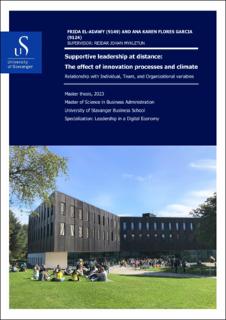| dc.description.abstract | The rapid growth in use of home office creates the opportunity for leaders to embrace new ways of working in order to drive innovation. This study aims to investigate how leaders can support employees to foster an innovation climate that can lead to better innovation processes, when working from home. To gain a more in-depth understanding, this study examines how innovation processes and innovation climate are related to each other. Moreover, the aim is to investigate to what extent the individual dimensions (work engagement, age, and gender), the team dimension (social support) and the organizational dimensions (autonomy, home office and supportive leadership) predict innovation processes and innovation climate. Furthermore, it is desired to study to what extent the patterns of relationships are similar for innovation processes and innovation climate when investigating the effects from the three levels.
To conduct this study a quantitative method was used where data was collected from 1531 participants representative of the Norwegian workforce during Covid-19. Reliability and validity were tested by factor and reliability analyses. Furthermore, a correlation analysis and multiple hierarchical regression analyses were conducted. The findings indicate a strong relationship and effect between innovation processes and innovation climate; thus, these two concepts reflect a strong predictability between each other. This study showed a complex association between age and gender with innovation processes and climate. Moreover, the results show that giving autonomy in the working method, increasing work engagement, providing social support, and having a leader that is supportive, have a positive effect on the innovation processes. However, supportive leadership presented no effect in one component of the innovation processes. There is a similar pattern for innovation climate, but in this case supportive leadership presented a stronger relationship and effect with innovation climate. Despite the stigma around the use of home office, this study revealed a favourable relationship between innovation processes and climate. Nonetheless the results of this study suggest further research on use of home office, age, and gender with innovation climate. | |
